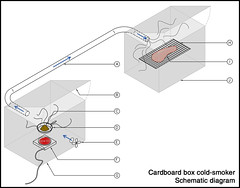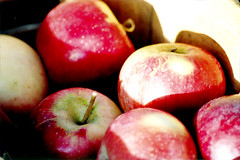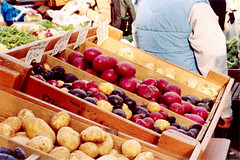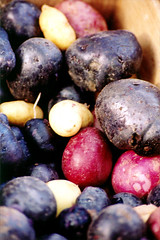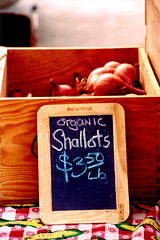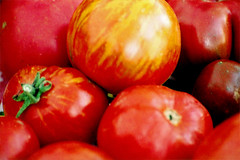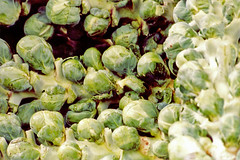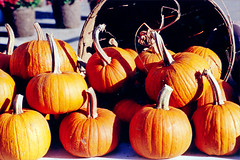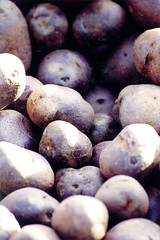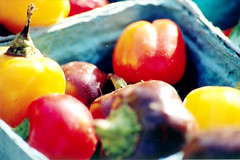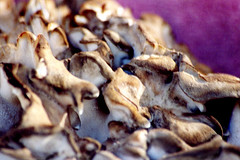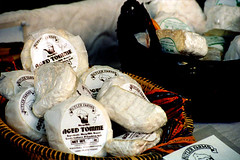Ah, the winter holidays: time for eating way too much. Unless you're me, spending a week and a half visiting parents and in-laws, where skipping a meal is sometimes preferable to actually eating. When the breakfast choice hangs between heavily-processed packaged foods1 and nothing, I'll wait until lunch.
Or dinner. Whatever.
Toss in a general disinterest in sweets - late-December holiday sweets being among the most sugar-intense of the year - and it's no wonder I'm itching to cook a meal for anyone who's around at any given time. Even something simple - like omelettes with bacon, caramelized onions and cheddar cheese - tends to go over well with the various folks who either don't cook or don't have time to cook.2
No surprise, then, that we cooked up a few grand meals to keep everyone happy. The first one, a last-minute menu before my brother and his fiancée left for Wisconsin, was a simple affair: a small salad of beets, beet greens and purple carrots; a cream of purple potato soup; a seared and roasted tri-tip steak from Fountain Prairie;3 whole-wheat and ricotta gnocchi; green beans with fresh lemon juice; and a braise of mushrooms and sweet onions in red wine. Then, for dessert, we had whole-wheat crepes, stuffed with fresh ricotta, strawberry jam and goat cheese, and topped with a rich lemon-egg sauce.4
The big meal, though, was the Christmas gift from Sharon and I to her parents, as well as a group of their friends - 9 in total. This was complicated by the following:
- Sharon's mom is really limited in what she can eat, texture-wise, to avoid the risk of her either choking or being unable to chew and swallow things. This meal was primarily for her, since she's unable to go out anymore, so it wasn't fair to prepare a nice meal for the others, then do something different for her.
- Sharon's parents' kitchen is well, kind of bare-bones. Most of the pots and pans are really thin metal, and just about everything is non-stick. It's better by my folks, but you still end up without the occasional thing you'd consider standard, like a cheese grater.
- My parents were invited to the dinner, as well as a number of people I didn't know at all. I know my mom's dietary restrictions, so those were easy to dance around, but everything needed to be simple enough to eliminate potentially unwanted ingredients at the last possible moment.
- We wanted the meal to highlight those things that Sharon's parents really like, but they're not particularly helpful in that regard. Asking them directly results in responses like "Oh, I'm sure anything you make will be fine."
It went over extremely well, and I'm quite happy about that. A few notes on the food details:amuse-bouche
asparagus, mushroom and lemon risotto
first course: soup
carrot and ginger soup, with spinach and roasted garlic puree, yogurt and fried onions
second course: seafood
seared scallops with bacon, orange and mustard cream sauce, and fresh asparagus
third course: pasta
blue cheese gnocchi with pear-white wine sauce, port wine reduction and toasted walnuts
fourth course: meat
braised beef with butternut squash spaetzle, and fresh green beans with lemon vinaigrette
fifth course: dessert
fresh ricotta with blackberry-port sauce and roasted apples
mignardises
rosemary-scented shortbread cookies
chocolate truffles
- I had really wanted to find some good, southeast-Asian fried shallots for the soup, but the Asian food selection in Downingtown is pretty limited. So I went with good, old, French's fried onions. The kind you usually find atop a cream-of-[insert vegetable here]-based casserole. Worked just fine.
- The bacon that accompanied the scallops was also in the package from Fountain Prairie. And, damn, was it ever a fine pairing with those scallops. As was the cream sauce, with consisted entirely of heavy cream, blood orange juice, dijon mustard and a little salt.
- Blue cheese works pretty well for gnocchi. I replaced half of the ricotta with a soft blue, and it lent a subtle flavor to the finished pasta. I also finally figured out the trick for properly rolling gnocchi off a fork to get that football-ish ridged shape, but haven't figured out how to explain it just yet.
- The pear-white wine sauce was really just a chunky applesauce, made with ripe anjou pears and a lot of riesling. I was going for the the classic combination of blue cheese pairings of port, pears and walnuts.
- I didn't actually toast the walnuts. I over-toasted the first batch, and didn't have time enough to get more ready to send out. In an open kitchen, where every move is visible from the dining room, I had to be really sneaky to get the burnt tray of nuts into the garage, out of the range of sight and smell.
- The braised beef was a beef cheek from, of course, Fountain Prairie. Sharon's parents have been making fun of us for eating it, though I don't see why it's any weirder than eating any other cow muscle. So we didn't tell them until afterwards, when her dad said something about how amazingly good it was. He no longer seemed creeped out by it.6
- The blackberry-port sauce was pretty much just that. A bag of frozen blackberries, a third of a bottle of port, and a cup of sugar or so. Simmer for half an hour and strain to get all the seeds out. A little pectin'd make it into a mighty fine jam.
- The chocolate truffles were another Wisconsin special, from Gail Ambrosius. All I want to know is this: Doesn't anyone other than me appreciate the goodness of chocolate and Indian curry? At least my dad'll eat the chilli-chocolate truffle.
1Such as frozen "French toast sticks" or other high-fructose corn syrup-based food products.
2That'd be our families, especially around the holidays, when just keeping the house tidy is a full-time job.
3Sent via FedEx, along with a boxful of other goodies intended for Christmas gifts. It was alarming to have regular, supermarket, corn-fed beef another night, and to taste the difference. The supermarket stuff was almost flavorless, by contrast.
4Kind of like a thinner version of lemon curd. I think the Joy called it "Rich Hot Lemon Sauce".
5Any changes were based on what we could find at the grocery store.
6It was just in a simple braise of whatever lager was in the fridge with onions, carrots, rosemary and sundried tomatoes.


